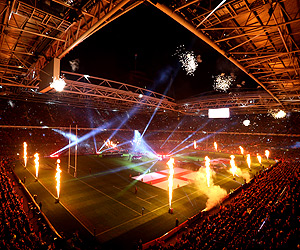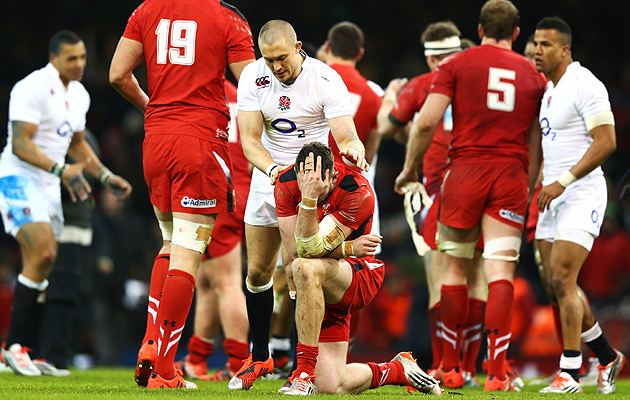Law Discussion: TMO phases
The score is 18-16 to England with five minutes or so left and England are on the attack. A try would make the game safe.
England win a Welsh throw-in at a line-out just over five metres from the Welsh line and form a ruck. Then James Haskell of England charges and is tackled. At that tackle a ruck forms. The ball comes back from a tackle to scrumhalf Richard Wigglesworth of England. Wigglesworth passes to Mako Vunipola who is tackled by Jamie Roberts of Wales. Again the ball comes back to Wigglesworth who passes to George Ford of England who passes Kieran Brookes who is tackled by Jonathan Davies of Wales with help from Luke Charteris. The ball comes quickly back to England. David Attwood snaps it up and dives over for a try. But the referee consults the TMO about the possibility of obstruction (crossing).
The commentator Brian Moore, a former England and B&I Lions hooker with serious law degrees who was a solicitor before changing to the media, and also a qualified referee, told the world that the referee was entitled to check up to two phases – "two phases prior to the try".
 The obstruction examined occurred when Wigglesworth passed to his right where Nick Easter (19) and Vunipola (17) were waiting. Easter moved forward into Dan Biggar, the Welsh flyhalf whose head was bandaged. Wigglesworth passed to Vunipola who was just behind Easter. Vunipola was tackled and then Brookes was tackled and then Attwood went over for the try.
The obstruction examined occurred when Wigglesworth passed to his right where Nick Easter (19) and Vunipola (17) were waiting. Easter moved forward into Dan Biggar, the Welsh flyhalf whose head was bandaged. Wigglesworth passed to Vunipola who was just behind Easter. Vunipola was tackled and then Brookes was tackled and then Attwood went over for the try.
After replays the decision by the referee, Jérôme Garcès of France, was that Easter had obstructed, the try was cancelled and Easter was penalised.
In The Telegraph on Wednesday, 11 February, Moore wrote on the match under a headline which included a "look into latest TMO controversies". On the obstruction, Moore wrote: "When England’s Dave Attwood grounded the ball on the Wales goal-line near the end of the game the referee was informed of a possible obstruction by Nick Easter in the preceding play. That incident was replayed several times and was, arguably correctly, called as obstruction. However, the TMO did not have the right to even view it, because it took place between the third and second phases preceding the grounding. The experimental variation to the TMO protocol expressly limits reviews to incidents within the immediate two phases. The decision was probably morally right; it was legally wrong."
This is what the TMO protocol says:
2.2 The potential infringement must have occurred between the last restart of play (set piece, penalty/free-kick, kick-off or restart) and the touch down but not further back in play than two previous rucks and/or mauls.
So there is truth in what Moore says but not the whole truth of the situation. It is important to define what 'phases' of play had happened. In fact it does not use the word phase but talks set piece, penalty/free kick, kick-off or restart, none of which had happened.
That leaves two previous rucks and mauls. There was certainly no maul in the section of the game we described. There may well have been no rucks either.
Law 16 DEFINITIONS
A ruck is a phase of play where one or more players from each team, who are on their feet, in physical contact, close around the ball on the ground. Open play has ended.
 When Vunipola was tackled there was no ruck. The only player on his feet who was over the ball on the ground was Billy Vunipola of England. Because there were no Welshmen, there was no ruck.
When Vunipola was tackled there was no ruck. The only player on his feet who was over the ball on the ground was Billy Vunipola of England. Because there were no Welshmen, there was no ruck.
At the tackle on Brookes it would take a stretch of the imagination to find a ruck; it, too, looks like a tackle only. The first players who comes in over Brookes is Jonathan Joseph. He is on his feet. If Charteris is on his feet when Joseph drives him away there may have been the remote possibility of a ruck's formation, but then Charteris must have been in a strange position of he was still on his feet.
That suggests that there were no rucks or mauls after Easter's obstruction, which suggests that Moore got it wrong.
When the referee was about to consult the TMO he said that his attention had been drawn to potential obstruction by the TMO.
Is the TMO allowed to do that?
2.1 If after a team in possession of the ball has touched the ball down in their opponents' in-goal area and any of the match officials (including the TMO) have a view that there was a potential infringement, of any nature, before the ball was carried into in-goal by the team that touched the ball down, they may suggest that the referee refers the matter to the TMO for review.
including the TMO. The TMO was right to bring the possible obstruction to the referee's decision.
The process that referee Garcès and TMO Simon McDowell of Ireland was correct in procedure and outcome.
It was all legally right.
Identifying what phase of play is happening is important for referees, and not always easy.



































